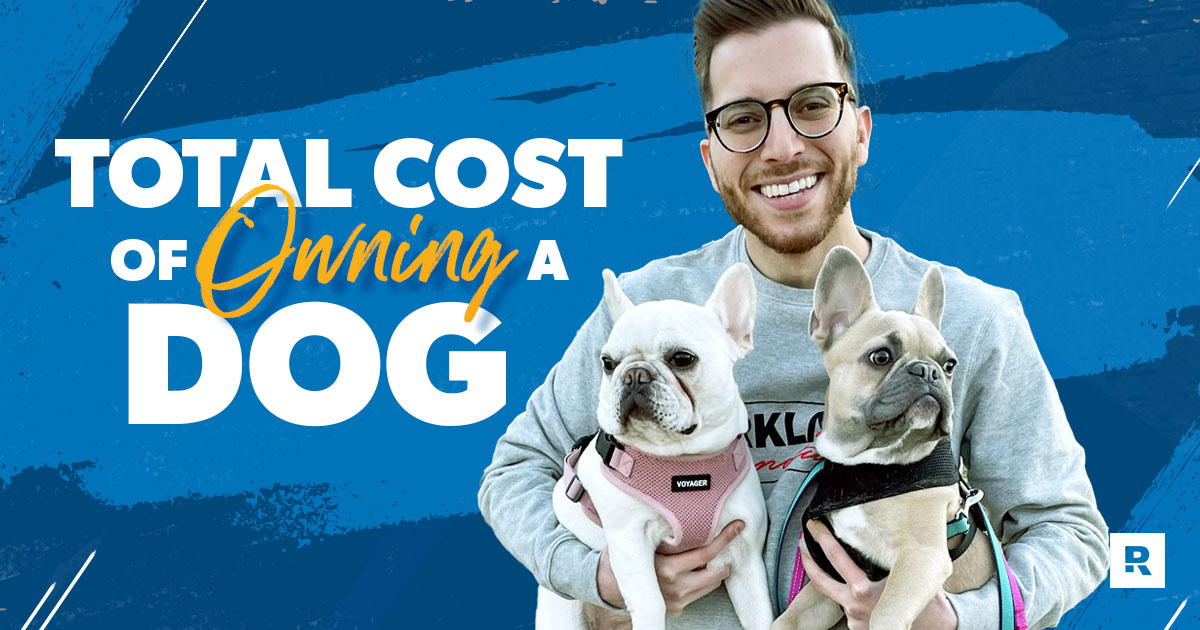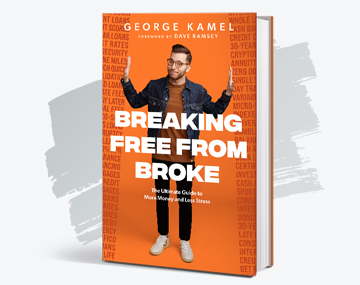My wife and I love our two French bulldogs, Olive and Blue. They add a lot of joy (and drool) to our lives. But I’m not going to lie: It takes a decent chunk of change to keep them happy, healthy and entertained enough that they don’t start a little Frenchie revolt in our house. (I’ve seen Les Mis . . . those Frenchies sure know how to revolt.)
I’m breaking down the most common expenses for dog owners so you can decide if you’re financially ready to become a dog parent yourself. Plus, I’ve got some ways to help you save money on your furry friends.
How Much Does a Dog Cost?
Americans really love their fur babies. In fact, dog owners spend an average of $730 on their canines each year—which breaks down to about $60 each month.1
Get expert money advice to reach your money goals faster!
But what exactly does that $730 pay for? It depends. When it comes to the cost of a dog, there are three main categories: new dog essentials, recurring expenses and optional extras. Let’s take a look at each.
New Dog Essentials
A dog is usually more expensive on the front end (even though a lot of the costs have to do with their rear end). Here are some of the initial things you can expect to pay for when you first get a dog:
|
Adoption Fees |
$0–350 |
|
Pet Store/Breeder |
$500–3,000 |
|
Initial Vet Exam and Vaccinations |
$100–350 |
|
Spay or Neuter Surgery |
$50–200 |
|
Heartworm Test |
$0–35 |
|
Collar or Harness |
$6–50 |
|
Leash |
$10–50 |
|
Food Bowls |
$10–50 |
|
Crate and Bed |
$25–250 |
|
Waste Pickup Bags |
$0–10 |
|
Potty Training Pads |
$10–20 |
|
Stain and Odor Removers |
$5–20 |
|
Food |
$25–75 |
|
Toys |
$5–80 |
|
Treats |
$5–115 |
|
Pet License (If Needed) |
$8–30 |
|
Apartment Pet Deposit (If Needed) |
$200+ |
|
Total Initial Dog Costs |
$259–4,535 |
Stats pulled from Petfinder, Forbes and conversations with lovely pet owners.2,3,4
Probably the most expensive cost for a new dog owner is the first vet appointment—which usually includes a wellness exam, basic vaccines and spay or neuter surgery (if needed). And if you’re one of those saints who’s adopting a dog that’s seen better days, just know you might have to spend a bit more to get Fido’s tail wagging again.
As far as what to buy for your new dog starter pack, you really only need the basics: food, food and water bowls, a leash and collar, and maybe a crate or bed for them to sleep in. (But what kind of dog parent would you be if you didn’t also get some fun treats and toys to make your pup feel more comfortable in their new home?)
Depending on where you live, you may need to get a pet license to register your dog (not to vote, but to show they have all their vaccines). Also, most apartment complexes require some sort of pet deposit—as well as a monthly fee—so make sure that fits in your budget. And if your dog isn’t house-trained yet and you want that pet deposit back later, be ready to buy plenty of pee pads and spot cleaner for those bound-to-happen messes.
More Money. Less Stress. Yes, Please.
In his new book, George Kamel does the research for you and exposes all the worst money traps out there so you can build real wealth!
Recurring Expenses
Even after you’ve purchased the doggie basics, there are still expenses each month and throughout the year you’ll have to cover. Here are the most common:
|
Food |
$25–75 a month $300–900 a year |
|
Flea/Tick/Heartworm Prevention |
$40–200 a year |
|
Waste Pickup Bags |
$0–100 a year |
|
Treats and Toys |
$50–250 a year |
|
Emergency Vet Visits |
$300–1,000+ |
|
Apartment Pet Fees (If Needed) |
$20+ a month $240+ a year |
|
Total Annual Expenses |
Obviously, monthly costs depend on the dog. A Great Dane will go through a large bag of dog food way faster than a teacup Chihuahua. And some breeds tend to have more health issues than others (like my French bulldogs, bred with stubby bodies and flat faces). Also, you’ll probably spend more money (and time) picking up after your dog if you don’t have a yard where they can do their business.
If you’ve got a chewer on your hands, it’s a good idea to have more chew toys or bones around to keep them busy. And you should probably go ahead and factor in how much it’ll cost to replace your shoes, eyeglasses (true story), cushions and other household objects Fluffy decides to sink her teeth into when you’re not looking.
Optional Extras
Then there are the things you may or may not need to spend money on, depending on your dog and your lifestyle. Some optional dog expenses include:
|
Microchip |
$25–60 |
|
Dental Cleaning |
$170–350 |
|
Wellness Vet Exams |
$50–250 |
|
Boarding or Sitting |
$18–120 per day |
|
Dog Walking |
$20–30 per walk |
|
Grooming |
$50–100 per appointment |
|
Shampoo and Brush |
$15–40 |
|
Nail Clippers |
$10–50 |
|
Travel Carrier |
$20–75 |
|
Training |
$250+7 |
Maybe you want you and your dog to wear matching bandanas. Maybe you love to take your four-legged companion on summer walks, but you need those little booties to protect their paws from the hot pavement. Maybe you’re planning to enroll your pup in a doggie daycare that’s equal to a Montessori preschool. Hey, all that is great—just make sure you’re able to pay for it.
Personally, my wife and I love to spoil Olive and Blue with dog walkers or daycare while we’re at work, monthly mobile grooming to keep them so fresh and so clean, and of course, specialized (and expensive) food for their 37 allergies.
So, whether you’re investing in agility training to raise a champion or you want to get one of those monthly dog toy subscription boxes, take the time to count the cost first.
Ways to Save Money on a Dog
As you can see, the price of owning a dog adds up faster than my Frenchies can dig out the peanut butter from a Kong toy. But there are some ways you can cut back on dog costs—while still giving your doggo the love they deserve.
Adopt a Shelter Dog
I get it: Sometimes the only way to get a certain dog breed is to buy from a breeder. But shelter dogs need homes too—and adopting a previously loved pooch can save you thousands of dollars on the front end. So, even if you’ve got a particular breed in mind, visit your local shelter or look online. You might just fall in love with an adorable mutt that won’t be as high maintenance as some of those problem-prone, purebred pups out there (like mine!).
Buy Used Dog Products
Crates, balls, leashes, toys—you don’t have to buy these things brand new. After all, Rover could care less if that frisbee already has a couple bite marks in it. Check out thrift stores or Facebook Marketplace, or see if any of your friends have any dog items they want to retire. Just give everything a good wash, and your little buddy has a new (to them) toy to play with for way less!
Do Your Own Grooming
Dog grooming appointments can be pricey (ask me how I know), especially if you’ve got a dog that requires regular maintenance. So, invest in some shampoo and a good pair of grooming scissors, watch some YouTube videos, and channel your inner Edward Scissorhands. Pro tip: The sooner you get your dog used to the process, the more likely they’ll be to sit still for you (treats help).
Consider Skipping Pet Insurance
Hot take: Pet insurance isn’t always worth it. Many have high deductibles you have to hit before expenses are covered, and your plan may not cover the exact procedure or medication you need. But if you’re still gung ho on getting pet insurance, do your research and due diligence, and prepare for the ongoing cost.
For most people, though, it’s better to skip the insurance to save on premiums and start a sinking fund instead. It’s kind of like a doggie savings account—but way safer than burying your money in the backyard. By setting aside a little bit every month, you’ll be able to cover those unexpected dog costs when they pop up, without overpaying for pet insurance.
Make it easier on yourself and download our EveryDollar budgeting app. EveryDollar does more than just help you track your spending and manage your money—it actually helps you find more margin every month!
Just download the app, answer a few questions, and we’ll build you a plan to free up thousands in margin to put toward your goals. Start EveryDollar for free right now!




